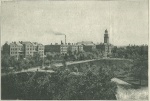Difference between revisions of "Portal:Featured Article Of The Week"
M-Explorer (talk | contribs) |
M-Explorer (talk | contribs) |
||
| Line 1: | Line 1: | ||
{{FAformat | {{FAformat | ||
| − | |Title= | + | |Title= Rochester State Hospital |
| − | |Image= | + | |Image= 10-18-2007-13a.jpg |
|Width= 150px | |Width= 150px | ||
| − | |Body= | + | |Body= By a special law passed by the Legislature of 1873 and amended in 1874 a tax of $10 on all liquor dealers was assessed to raise a fund for the establishment of a state inebriate asylum which, when completed, was to be maintained by a continuation of the same tax. As soon as a sufficient fund was accumulated the Inebriate Asylum Board purchased a farm of 160 acres, within a mile and a half of the City of Rochester, for $9000, secured plans and began building in 1877. Strong opposition was raised by liquor dealers against this tax as discriminating and unjust. Test cases were tried in the courts and the constitutionality of the law was sustained. At the same time it became apparent and was admitted generally that additional room was much more urgently needed for the care of the rapidly increasing insane of the state than for the care of inebriates. The Legislature of 1878, in view of this and of the determined opposition to an inebriate asylum to be built and maintained on such a plan, repealed the act levying the tax and changed the inebriate asylum to the Second Minnesota Hospital for Insane, which title was later changed to the Rochester State Hospital (in 1883), with the proviso, however, that inebriates should be admitted and cared for and treated at the expense of the state on the same basis as the insane. Accordingly a separate ward was maintained for inebriates until the department was abolished by the Legislature in 1897. |
| − | The | + | The building was in an unfinished condition, and consisted of a center and small east wing, then only under roof, without inside finish, and without outbuildings, such as laundry and engine house. When the trustees examined the property they recognized its unfitness for the purposes of an insane hospital and the fact that it would necessarily require many changes to adapt it to this new use. Owing to these objections they hesitated to accept the transfer; but the urgency for room was so great they reluctantly concluded to do the best they could with it. An appropriation of $15,000 accompanied the transfer as a fund to be used to prepare the building for the accommodation of patients. This was in the summer of 1878. [[Rochester State Hospital|Click here for more...]] |
}} | }} | ||
Revision as of 03:58, 31 March 2024
Featured Article Of The Week
Rochester State Hospital
By a special law passed by the Legislature of 1873 and amended in 1874 a tax of $10 on all liquor dealers was assessed to raise a fund for the establishment of a state inebriate asylum which, when completed, was to be maintained by a continuation of the same tax. As soon as a sufficient fund was accumulated the Inebriate Asylum Board purchased a farm of 160 acres, within a mile and a half of the City of Rochester, for $9000, secured plans and began building in 1877. Strong opposition was raised by liquor dealers against this tax as discriminating and unjust. Test cases were tried in the courts and the constitutionality of the law was sustained. At the same time it became apparent and was admitted generally that additional room was much more urgently needed for the care of the rapidly increasing insane of the state than for the care of inebriates. The Legislature of 1878, in view of this and of the determined opposition to an inebriate asylum to be built and maintained on such a plan, repealed the act levying the tax and changed the inebriate asylum to the Second Minnesota Hospital for Insane, which title was later changed to the Rochester State Hospital (in 1883), with the proviso, however, that inebriates should be admitted and cared for and treated at the expense of the state on the same basis as the insane. Accordingly a separate ward was maintained for inebriates until the department was abolished by the Legislature in 1897.
The building was in an unfinished condition, and consisted of a center and small east wing, then only under roof, without inside finish, and without outbuildings, such as laundry and engine house. When the trustees examined the property they recognized its unfitness for the purposes of an insane hospital and the fact that it would necessarily require many changes to adapt it to this new use. Owing to these objections they hesitated to accept the transfer; but the urgency for room was so great they reluctantly concluded to do the best they could with it. An appropriation of $15,000 accompanied the transfer as a fund to be used to prepare the building for the accommodation of patients. This was in the summer of 1878. Click here for more...
